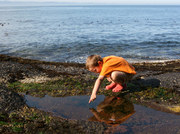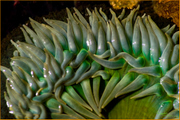
Photo credits:
Child at Salt Creek
by Dave Logan
Giant Green Anemone
by Randall Tomaras
It's time to explore...
... the miniature world of tidepools on the Olympic Peninsula's Strait of Juan de Fuca beaches.
Constantly shaped and re-shaped by the actions of sun, wind, water, and rock, tidepools are a distinctive and somewhat harsh habitat where the ocean water meets the land. Life is tough for plants and animals that live in tidepools. Wind and water continually pound at the rocks and the sun can be harsh. Nevertheless, the rugged Olympic Peninsula coastline teems with life! Sea stars, barnacles, urchins, anemones, tubeworms, piddock clams and sea snails thrive in these little pools -- and one square foot may support thousands of these tenacious little sea creatures.
Tidepools are actually divided into four zones - splash, high-tide, mid-tide and low-tide. Children seem to find these mini-worlds captivating and there are many local and online resources to help guide a day at the beach.
Salt Creek Recreation Area and the Tongue Point Marine Life Sanctuary is world-famous for tidepool exploration. In addition to endless rocky tidal pools, you'll find a County Park, with 90 campsites, sandy beaches, a playground and play fields and hiking trails to Striped Peak. And you can wander around the original bunkers that were once part of Fort Hayden during World War II. Tongue Point is noted as being the eastern-most located habitat example of open rock coast intertidal habitat in the Strait of Juan de Fuca and is also designated a bird watching site by the Audubon Society.
Directions:
From Highway 112 at Milepost (MP) 53.8, turn north on Camp Hayden Road. Follow for about 3.5 miles to the county park entrance.

Clallam Bay Park and Slip Point is an outdoor aquarium where one can examine tidepool animals and sealife under the watchful eye of the historic lighthouse residence.
Directions:
Clallam Bay Spit and Slip Point Beach are located at MP 17.
Olympic Coast National Marine Sanctuary. This unique sanctuary forms the western edge of the Olympic Peninsula. The sanctuary shares 65 miles of coastline with Olympic National Park, and has a total area of over 3,300 square miles.
Directions:
Highway 112, at Milepost 0, becomes the Makah Reservation. Upon entering the reservation, you will need to purchase a recreation permit. Continue west, turn left on Cape Flattery Road and drive three miles to Hobuck Beach Road. Turn left and continue to drive (the road becomes Sooes Beach Road) to the Shi Shi beach trailhead that is clearly marked on the right. The parking area is for day use only. Overnight parking is only allowed in designated private parking lots. Watch for signs.
Shi Shi Beach and the Olympic Coast National Marine Sanctuary can also be accessed by hiking from the Ozette Wilderness area shoreline.
